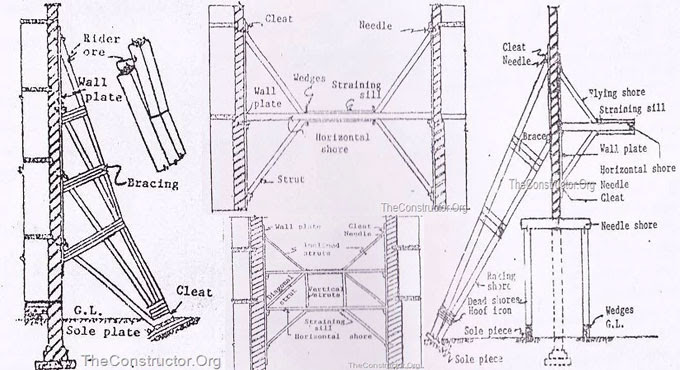It is the construction of a short-lived structure to support provisionally an unsafe structure which supports walls laterally.
This construction process can be used when walls come out or when walls crack due to unequal settlement of foundation and repairs are to be conducted to the cracked wall or when a close structure needs bringing down or when openings are to be newly made or enlarged in a wall.
Types of Shoring:
1. Raking Shoring: in this process, the inclined members known as rakers are used to give sideways supports to walls. A raking shore has some components which are- Rakers or inclined member, Wall plate, Needles, Cleats, Bracing and Sole Plate. Here are some points to keep in mind while use of raking shores, like:
a) Rakers are to be disclosed in the ground at 45°,
b) in the tall buildings the length can be reduced by applying rider raker,
c) they should be properly braced at intervals,
d) the size is to be measured as per the anticipated thrust from the wall,
e) the centre line of a raker and the wall should meet at floor level,
f) shoring may be spaced at 3-4.5 m spacing to cover long length of the bar etc.
2. Flying Shoring: It is a system that gives supports to the party walls of the two buildings where the intermediate building is to be pulled down and rebuilt.
This shore consists of wall plates, needles, cleats, horizontal shores or struts and inclined struts in different forms that vary on situation. The wall plates are placed against the wall and secured to it.
3. Dead shoring: It is the system of shoring used to render vertical support to the walls and roofs, floors etc. when the lower part of a wall has been removed to provide an opening in the wall or to rebuild a defective load bearing wall in a structure.
This shore consists of an arrangement of beams and posts which need to support the weight of the structure above and transfer same to the ground on firm foundation below. The shores stand away from wall on either side to allow working space while the needles are props are in position.
Article Source: theconstructor.org

~~~~~~~~~~~~~~~~~~~~~~~~
Published By
Rajib Dey
www.constructioncost.co
~~~~~~~~~~~~~~~~~~~~~~~~
This construction process can be used when walls come out or when walls crack due to unequal settlement of foundation and repairs are to be conducted to the cracked wall or when a close structure needs bringing down or when openings are to be newly made or enlarged in a wall.
Types of Shoring:
1. Raking Shoring: in this process, the inclined members known as rakers are used to give sideways supports to walls. A raking shore has some components which are- Rakers or inclined member, Wall plate, Needles, Cleats, Bracing and Sole Plate. Here are some points to keep in mind while use of raking shores, like:
a) Rakers are to be disclosed in the ground at 45°,
b) in the tall buildings the length can be reduced by applying rider raker,
c) they should be properly braced at intervals,
d) the size is to be measured as per the anticipated thrust from the wall,
e) the centre line of a raker and the wall should meet at floor level,
f) shoring may be spaced at 3-4.5 m spacing to cover long length of the bar etc.
2. Flying Shoring: It is a system that gives supports to the party walls of the two buildings where the intermediate building is to be pulled down and rebuilt.
This shore consists of wall plates, needles, cleats, horizontal shores or struts and inclined struts in different forms that vary on situation. The wall plates are placed against the wall and secured to it.
3. Dead shoring: It is the system of shoring used to render vertical support to the walls and roofs, floors etc. when the lower part of a wall has been removed to provide an opening in the wall or to rebuild a defective load bearing wall in a structure.
This shore consists of an arrangement of beams and posts which need to support the weight of the structure above and transfer same to the ground on firm foundation below. The shores stand away from wall on either side to allow working space while the needles are props are in position.
Article Source: theconstructor.org
~~~~~~~~~~~~~~~~~~~~~~~~
Published By
Rajib Dey
www.constructioncost.co
~~~~~~~~~~~~~~~~~~~~~~~~
No comments:
Post a Comment